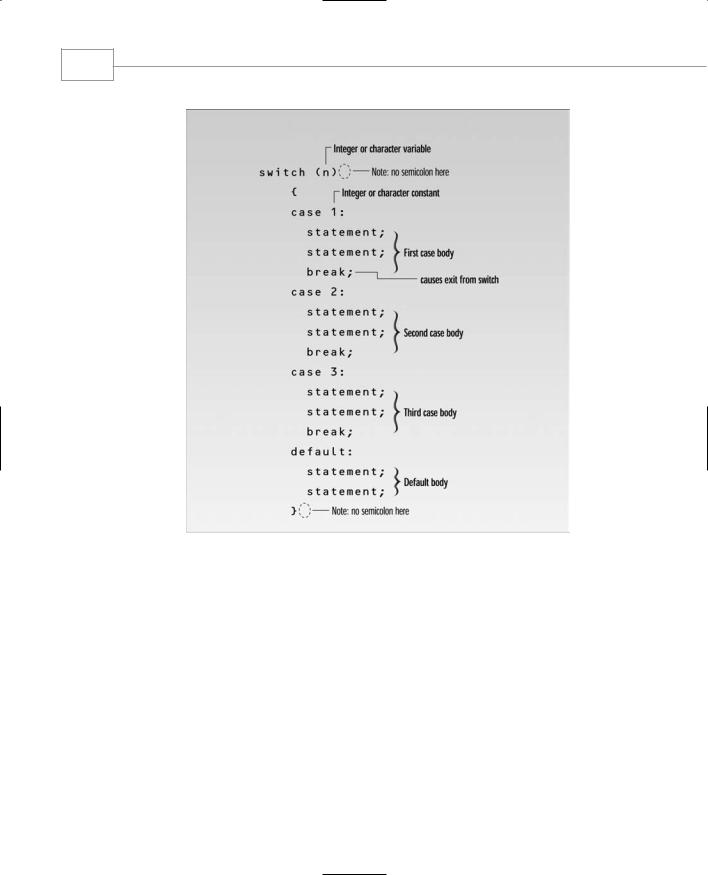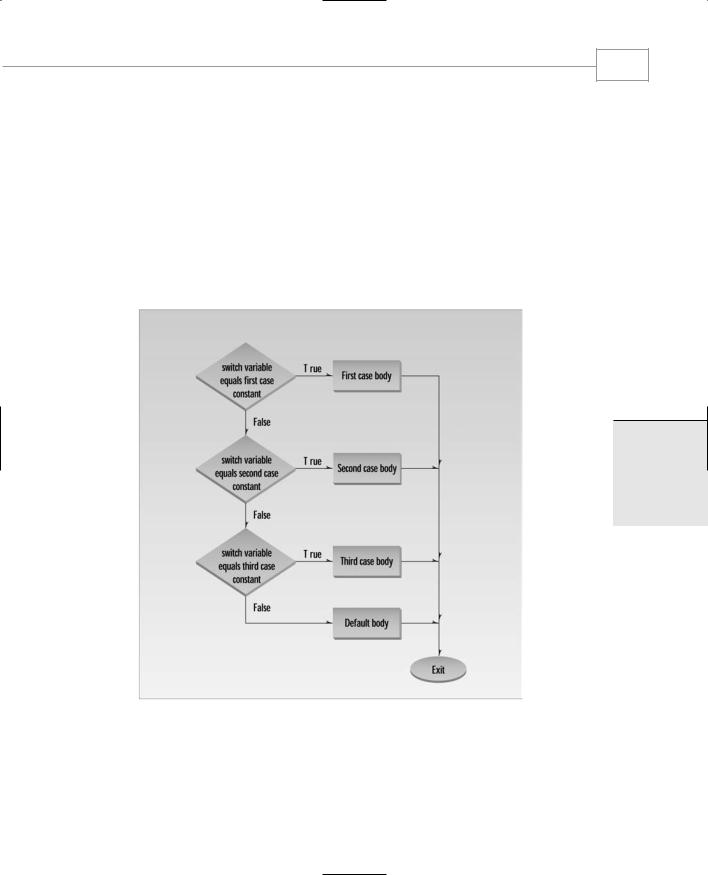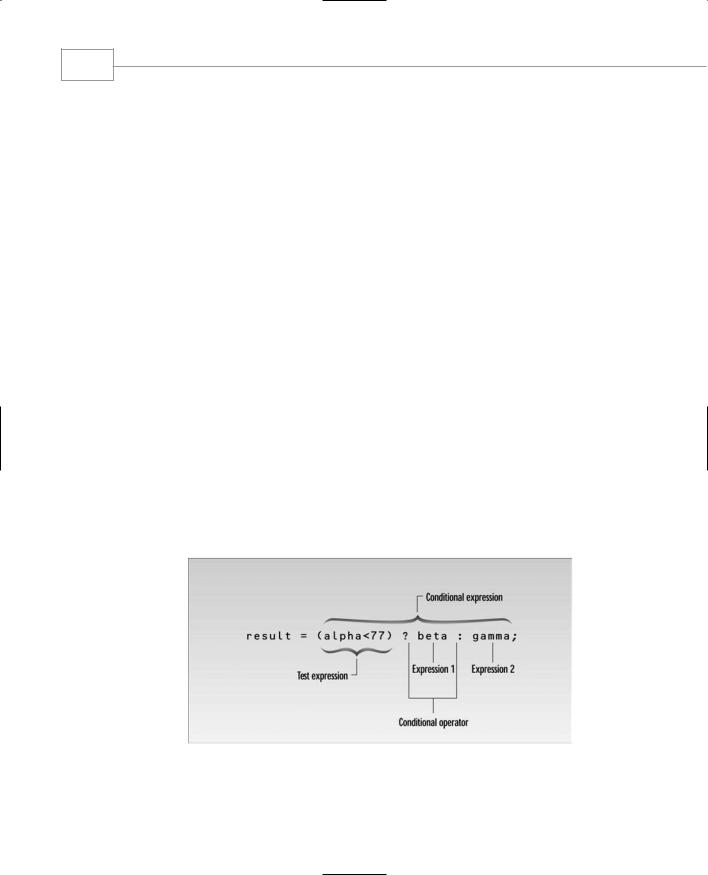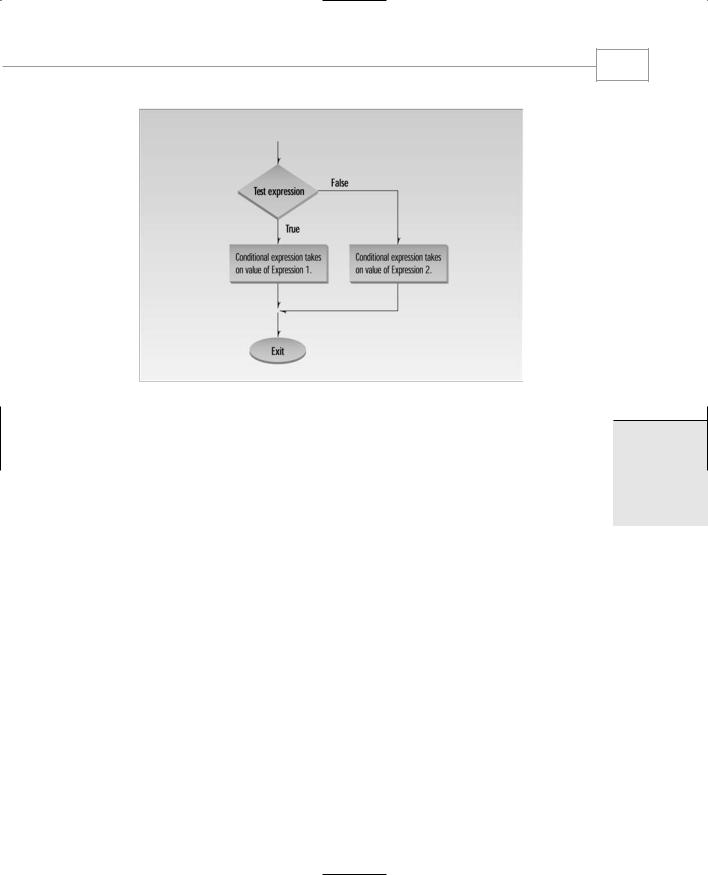
lafore_robert_objectoriented_programming_in_c
.pdf
Loops and Decisions
105
if( a==b ) if( b==c )
cout << “a, b, and c are the same\n”;
else
cout << “a and b are different\n”; return 0;
}
We’ve used multiple values with a single cin. Press Enter following each value you type in; the three values will be assigned to a, b, and c.
What happens if you enter 2, then 3, and then 3? Variable a is 2, and b is 3. They’re different, so the first test expression is false, and you would expect the else to be invoked, printing a and b are different. But in fact nothing is printed. Why not? Because the else is matched with the wrong if. The indentation would lead you to believe that the else is matched with the first if, but in fact it goes with the second if. Here’s the rule: An else is matched with the last if that doesn’t have its own else.
Here’s a corrected version:
if(a==b)
if(b==c)
cout << “a, b, and c are the same\n”; else
cout << “b and c are different\n”;
We changed the indentation and also the phrase printed by the else body. Now if you enter 2, 3, 3, nothing will be printed. But entering 2, 2, 3 will cause the output
b and c are different
If you really want to pair an else with an earlier if, you can use braces around the inner if:
if(a==b)
{
if(b==c)
cout << “a, b, and c are the same”;
}
else
cout << “a and b are different”;
Here the else is paired with the first if, as the indentation indicates. The braces make the if within them invisible to the following else.
3
DECISIONS LOOPS
AND

Chapter 3
106
The else...if Construction
The nested if...else statements in the ADIFELSE program look clumsy and can be hard—for humans—to interpret, especially if they are nested more deeply than shown. However, there’s another approach to writing the same statements. We need only reformat the program, obtaining the next example, ADELSEIF.
//adelseif.cpp
//demonstrates ELSE...IF with adventure program #include <iostream>
using namespace std;
#include <conio.h> |
//for getche() |
int main()
{
char dir=’a’; int x=10, y=10;
cout << |
“Type Enter to quit\n”; |
||
while( dir |
!= ‘\r’ ) |
//until Enter is typed |
|
{ |
|
|
|
cout |
<< |
“\nYour location is “ << x << “, “ << y; |
|
cout |
<< |
“\nPress direction key (n, s, e, w): “; |
|
dir = getche(); |
//get character |
||
if( dir==’n’) |
//go north |
||
y--; |
|
|
|
else |
if( dir==’s’ ) |
//go south |
|
y++; |
|
|
|
else |
if( dir==’e’ ) |
//go east |
|
x++; |
|
|
|
else |
if( dir==’w’ ) |
//go west |
|
x--; |
|
|
|
} //end while |
|
||
return 0; |
|
|
|
}//end main
The compiler sees this as identical to ADIFELSE, but we’ve rearranged the ifs so they directly follow the elses. The result looks almost like a new keyword: else if. The program goes down the ladder of else ifs until one of the test expressions is true. It then executes the following statement and exits from the ladder. This format is clearer and easier to follow than the if...else approach.

Loops and Decisions
The switch Statement
If you have a large decision tree, and all the decisions depend on the value of the same variable, you will probably want to consider a switch statement instead of a ladder of if...else or else if constructions. Here’s a simple example called PLATTERS that will appeal to nostalgia buffs:
// platters.cpp
// demonstrates SWITCH statement #include <iostream>
using namespace std;
int main() |
|
{ |
|
int speed; |
//turntable speed |
cout << “\nEnter 33, 45, or 78: “; |
|
cin >> speed; |
//user enters speed |
switch(speed) |
//selection based on speed |
{ |
|
case 33: |
//user entered 33 |
cout << “LP album\n”; |
|
break; |
|
case 45: |
//user entered 45 |
cout << “Single selection\n”; |
|
break; |
|
case 78: |
//user entered 78 |
cout << “Obsolete format\n”; |
|
break; |
|
} |
|
return 0; |
|
} |
|
This program prints one of three possible messages, depending on whether the user inputs the number 33, 45, or 78. As old-timers may recall, long-playing records (LPs) contained many songs and turned at 33 rpm, the smaller 45’s held only a single song, and 78s were the format that preceded LPs and 45s.
The keyword switch is followed by a switch variable in parentheses. switch(speed)
Braces then delimit a number of case statements. Each case keyword is followed by a constant, which is not in parentheses but is followed by a colon.
case 33:
The data type of the case constants should match that of the switch variable. Figure 3.12 shows the syntax of the switch statement.
107
3
DECISIONS LOOPS
AND

Chapter 3
108
FIGURE 3.12
Syntax of the switch statement.
Before entering the switch, the program should assign a value to the switch variable. This value will usually match a constant in one of the case statements. When this is the case (pun intended!), the statements immediately following the keyword case will be executed, until a break is reached.
Here’s an example of PLATTER’s output:
Enter 33, 45, or 78: 45
Single selection

Loops and Decisions
109
The break Statement
PLATTERS has a break statement at the end of each case section. The break keyword causes the entire switch statement to exit. Control goes to the first statement following the end of the switch construction, which in PLATTERS is the end of the program. Don’t forget the break; without it, control passes down (or “falls through”) to the statements for the next case, which is usually not what you want (although sometimes it’s useful).
If the value of the switch variable doesn’t match any of the case constants, control passes to the end of the switch without doing anything. The operation of the switch statement is shown in Figure 3.13. The break keyword is also used to escape from loops; we’ll discuss this soon.
3
DECISIONS
LOOPS
AND
FIGURE 3.13
Operation of the switch statement.

Chapter 3
110
switch Statement with Character Variables
The PLATTERS example shows a switch statement based on a variable of type int. You can also use type char. Here’s our ADELSEIF program rewritten as ADSWITCH:
//adswitch.cpp
//demonstrates SWITCH with adventure program #include <iostream>
using namespace std;
#include <conio.h> |
//for getche() |
int main()
{
char dir=’a’; int x=10, y=10;
while( dir |
!= ‘\r’ ) |
|
{ |
|
|
cout << |
“\nYour location is “ << x << “, |
“ << y; |
cout << |
“\nEnter direction (n, s, e, w): |
“; |
dir = getche(); |
//get character |
|
switch(dir) |
|
//switch on it |
{ |
|
|
case ‘n’: |
y--; break; |
//go north |
case ‘s’: |
y++; break; |
//go south |
case ‘e’: |
x++; break; |
//go east |
case ‘w’: |
x--; break; |
//go west |
case ‘\r’: |
cout << “Exiting\n”; break; |
//Enter key |
default: |
cout << “Try again\n”; |
//unknown char |
}//end switch
}//end while return 0;
}//end main
A character variable dir is used as the switch variable, and character constants ‘n’, ‘s’, and so on are used as the case constants. (Note that you can use integers and characters as switch variables, as shown in the last two examples, but you can’t use floating-point numbers.)
Since they are so short, the statements following each case keyword have been written on one line, which makes for a more compact listing. We’ve also added a case to print an exit message when Enter is pressed.
The default Keyword
In the ADSWITCH program, where you expect to see the last case at the bottom of the switch construction, you instead see the keyword default. This keyword gives the switch construction a way to take an action if the value of the loop variable doesn’t match any of the case constants. Here we use it to print Try again if the user types an unknown character. No break is necessary after default, since we’re at the end of the switch anyway.

Loops and Decisions
111
A switch statement is a common approach to analyzing input entered by the user. Each of the possible characters is represented by a case.
It’s a good idea to use a default statement in all switch statements, even if you don’t think you need it. A construction such as
default:
cout << “Error: incorrect input to switch”; break;
alerts the programmer (or the user) that something has gone wrong in the operation of the program. In the interest of brevity we don’t always include such a default statement, but you should, especially in serious programs.
switch Versus if...else
When do you use a series of if...else (or else if) statements, and when do you use a switch statement? In an else if construction you can use a series of expressions that involve unrelated variables and are as complex as you like. For example:
if( SteamPressure*Factor > 56 ) // statements
else if( VoltageIn + VoltageOut < 23000) // statements
else if( day==Thursday )
//statements
else
//statements
In a switch statement, however, all the branches are selected by the same variable; the only thing distinguishing one branch from another is the value of this variable. You can’t say
case a<3:
// do something break;
The case constant must be an integer or character constant, like 3 or ‘a’, or an expression that evaluates to a constant, like ‘a’+32.
When these conditions are met, the switch statement is very clean—easy to write and to understand. It should be used whenever possible, especially when the decision tree has more than a few possibilities.
The Conditional Operator
Here’s a strange sort of decision operator. It exists because of a common programming situation: A variable is given one value if something is true and another value if it’s false. For example, here’s an if...else statement that gives the variable min the value of alpha or the value of beta, depending on which is smaller:
3
DECISIONS LOOPS
AND

Chapter 3
112
if( alpha < beta ) min = alpha;
else
min = beta;
This sort of construction is so common that the designers of C++ (actually the designers of C, long ago) invented a compressed way to express it: the conditional operator. This operator consists of two symbols, which operate on three operands. It’s the only such operator in C++; other operators operate on one or two operands. Here’s the equivalent of the same program fragment, using a conditional operator:
min = (alpha<beta) ? alpha : beta;
The part of this statement to the right of the equal sign is called the conditional expression:
(alpha<beta) ? alpha : beta |
// conditional expression |
The question mark and the colon make up the conditional operator. The expression before the question mark
(alpha<beta)
is the test expression. It and alpha and beta are the three operands.
If the test expression is true, the entire conditional expression takes on the value of the operand following the question mark: alpha in this example. If the test expression is false, the conditional expression takes on the value of the operand following the colon: beta. The parentheses around the test expression aren’t needed for the compiler, but they’re customary; they make the statement easier to read (and it needs all the help it can get). Figure 3.14 shows the syntax of the conditional statement, and Figure 3.15 shows its operation.
FIGURE 3.14
Syntax of the conditional operator.

Loops and Decisions
113
FIGURE 3.15
Operation of the conditional operator.
The conditional expression can be assigned to another variable or used anywhere a value can be used. In this example it’s assigned to the variable min.
Here’s another example: a statement that uses a conditional operator to find the absolute value of a variable n. (The absolute value of a number is the number with any negative sign removed, so it’s always positive.)
absvalue = n<0 ? -n : n;
If n is less than 0, the expression becomes -n, a positive number. If n is not less than 0, the expression remains n. The result is the absolute value of n, which is assigned to absvalue.
Here’s a program, CONDI.CPP, that uses the conditional operator to print an x every eight spaces in a line of text. You might use this to see where the tab stops are on your screen.
//condi.cpp
//prints ‘x’ every 8 columns
//demonstrates conditional operator #include <iostream>
using namespace std;
int main()
{
3
DECISIONS LOOPS
AND

114 |
Chapter 3 |
|
for(int |
j=0; j<80; j++) |
//for every column, |
{ |
|
//ch is ‘x’ if column is |
char |
ch = (j%8) ? ‘ ‘ : ‘x’; |
//multiple of 8, and |
cout |
<< ch; |
//’ ‘ (space) otherwise |
} |
|
|
return 0; |
|
|
} |
|
|
Some of the right side of the output is lost because of the page width, but you can probably imagine it:
x x x x x x x x x
As j cycles through the numbers from 0 to 79, the remainder operator causes the expression (j % 8) to become false—that is, 0—only when j is a multiple of 8. So the conditional expression
(j%8) ? ‘ ‘ : ‘x’
has the value ‘ ‘ (the space character) when j is not a multiple of 8, and the value ‘x’ when it is.
You may think this is terse, but we could have combined the two statements in the loop body into one, eliminating the ch variable:
cout << ( (j%8) ? ‘ ‘ : ‘x’ );
Hotshot C++ (and C) programmers love this sort of thing—getting a lot of bang from very little code. But you don’t need to strive for concise code if you don’t want to. Sometimes it becomes so obscure it’s not worth the effort. Even using the conditional operator is optional: An if...else statement and a few extra program lines will accomplish the same thing.
Logical Operators
So far we’ve seen two families of operators (besides the oddball conditional operator). First are the arithmetic operators +, -, *, /, and %. Second are the relational operators <, >, <=, >=, ==, and !=.
Let’s examine a third family of operators, called logical operators. These operators allow you to logically combine Boolean variables (that is, variables of type bool, with true or false values). For example, today is a weekday has a Boolean value, since it’s either true or false.
Another Boolean expression is Maria took the car. We can connect these expressions logically: If today is a weekday, and Maria took the car, then I’ll have to take the bus. The logical connection here is the word and, which provides a true or false value to the combination of the two phrases. Only if they are both true will I have to take the bus.
